We independently evaluate all recommended products and services. Any products or services put forward appear in no particular order. If you click on links we provide, we may receive compensation.

Gerber Assert
Quality/Performance - 79%
Value for Money - 68%
74%
- Pros: Extremely light and thin, carries great, adjustable thumb stud is a fresh new idea, practical and useful blade shape, good quality, good action.
- Cons: Priced too high versus competitors, sharpening choil traps material when cutting, Benchmade and Hogue have better action at this price point.
There’s an old idiom that says “good things come in small packages” – that just because something’s small doesn’t mean it’s not worth admiration. I think that’s certainly true when it comes to pocket knives, because my bell curve of greatness skews to the left, where I find a lot more utility and usefulness and general enjoyment in small knives. I know there are compelling use cases for a Becker BK-9 Combat Bowie, with its 9” long blade, but they certainly aren’t mine. What am I really going to do with a 4” folding knife, either? Sure, I want a Cold Steel 4-Max – with its huge blade, bomb-proof lock, sculpted G10 scales and titanium liners, and crazy ergonomics. But what am I actually going to do with a 10.2 ounce pocket knife other than complain about it?
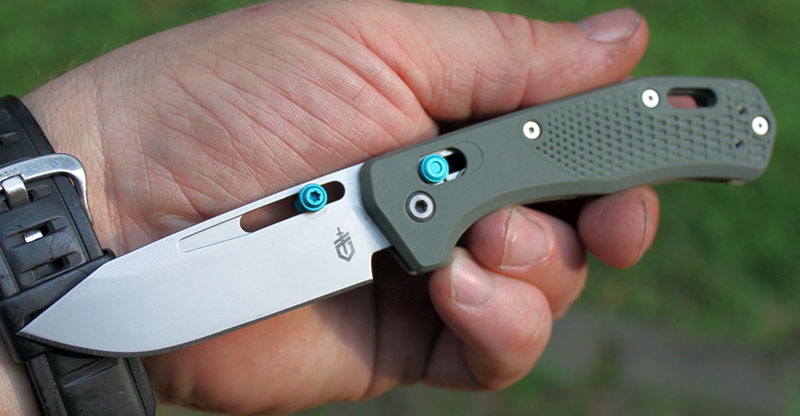
No, for me, functional pocket knives hit their sweet spot when they’re under 3 ounces and under 3 inches of blade length. When you get down into the 2” blade length you’ve got to work around the short blade length rather than it working for you, and I find the same to be true for the kind of tasks I’m typically doing with something 4” or over – too short and it’s not enough cutting edge to easily accomplish things, too long and it’s unwieldy. And when you’re adapting to the knife rather than vice versa, I think that’s a flaw.
Key Specs: Gerber Assert
So if lightweight and around 3” of blade length is the peak of the bell curve, then the new Gerber Assert folder is aimed directly at it. Mind you, the Assert is far from alone in this segment – the list of lightweight 3” locking folders is long and impressive, as we’ll get into – but this new knife from the brand that used to be a punchline in knife connoisseur jokes is yet another sign that Gerber is actually taking the idea of making good knives seriously – after the Fastball, Sedulo, and Savvy folders all impressed with their materials and design. The Assert is smaller and lighter than all of those, slipping into the sub-two-ounce category of ultra-light carry knives, offering the usability and practicality of a regular folder but with super-slim construction and “forget it’s even there” weight in the pocket. Removing that much weight and mass from a knife can be hit-or-miss, though, so whether it’s any good remains to be seen. Let’s dive in.
The Blade
If you’re making an ultra-light folding knife, it makes sense to avoid impractical blade shapes. After all, ultra-light knives are designed around functionality, so having a recurved reverse tanto or something like that wouldn’t make much sense, which is why Gerber went with a flat-ground drop point here, widely considered the most useful blade shape in pocket knives. In a nice change of pace, the grind line is pretty high up the blade, a thing which bothered me on the Savvy and the Fastball – both of which had relatively narrow blade profiles and medium-height grind lines that made the geometry of the edge chunky for no reason. Here, the flat grind goes up to just below the opening for the thumb stud, giving the best slicing geometry possible in combination with the super-thin 0.09” stock the blade is cut from. The blade is made from CPM-S30V powdered metallurgy stainless steel, an older but still high-performance alloy that is highly corrosion resistant and holds an edge for a long time.
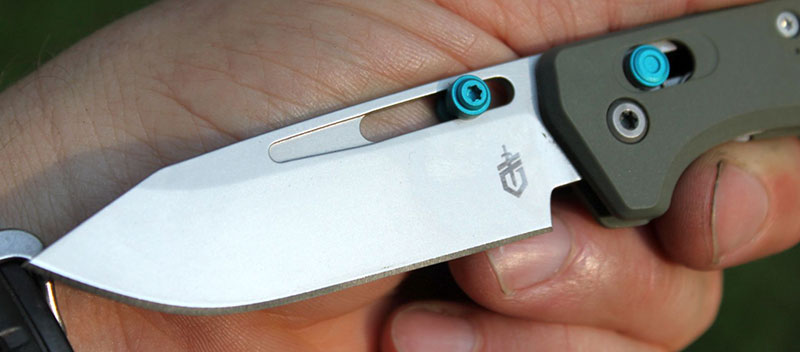
Blade length is just under 3” (according to Gerber, 2.98”) with a 2.80” cutting edge owing to the sharpening choil at the base of the blade. While that is very thin stock, the profile of the spine maintains as much thickness as possible as it goes out towards the tip, only starting to taper down when the spine turns down to maximize blade strength. The primary bevel sweeps from the forward edge of the spine across the blade and into a diagonal plunge line that terminates behind the scales, leaving a steep sharpening choil with a tiny bit of beard at the terminating edge. The blade has a very muted stonewashed finish with the Gerber shield logo etched on one side, and the steel type, a serial number, and “Made In USA” on the other.
Deployment & Lockup
The Assert utilizes Gerber’s “Pivot Lock” which functions like an AXIS lock or any of the other myriad competitors that have emerged onto the market since Benchmade’s functional patent on the design expired several years ago. It uses a bar actuated by two springs that slides on top of the tang of the blade to lock it in place, as well as creating detent pressure in the closed position, and the blade is located in the open position by an external stop pin that’s anchored to the liners.

Deployment on the knife is via dual ambidextrous thumb studs or a thumb groove/fuller that runs parallel to the spine, and here we get the Gerber’s party trick: adjustable and removable thumb studs. While Gerber’s web page on the Assert glosses over this and their video doesn’t really explain it, it’s worth diving into a little deeper. The thumb stud is asymmetric, longer on one side than the other, with a single Torx T8 fitting on the long side. Since the thumb stud sits in the fuller groove, you can loosen the thumb stud screw and adjust its position fore and aft, as well as reverse its direction if you’re left-handed, or remove the thumb stud entirely if you prefer to use the fuller groove to open – or if you live somewhere where a one-handed opening knife is frowned upon.

Out of the box, the thumb stud came positioned about 1/3 of the way forward from the rearmost position in the fuller, and the action in that configuration was mediocre. Once I figured out how the adjustable thumb stud worked, I moved the stud all the way to the rearmost position to maximize leverage on the thumb stud, putting it as close as possible to the pivot. This, plus loosening the pivot screw about a half-turn, dials in the action to nearly perfect. It won’t drop shut under its own weight – after all, the blade is very light and it’s on washers, not bearings – but the deployment with the thumb stud and pivot dialed in is very light and fun, and it makes a satisfying snap when you close it with a little wrist action. While the adjustment of the thumb stud is probably something you’ll only do once and never mess with it again, it’s a pretty neat level of adjustment for a knife considering everyone’s level of dexterity is different and this makes the knife much more adaptable to different people’s hands.
Features, Fit & Finish
The Assert’s construction is textured polymer handles over nested stainless partial liners. Those liners only extend as far back as about the forward tip of the pocket clip, since they’re just there to support the lock mechanism, stop pin, washers (more on that in a second) and contain the crossbar lock springs. Behind that, the Assert is just poly handles supported by hourglass-shaped standoffs. It’s held together by a series of inset Torx screws, with three T6 screws per side (the forward one screwing into the liner, the rear ones screwing into the standoffs) and Torx screws in the pivot. Unusually, one side of the pivot is a T10 and the other side is a T8, with the T8 side being the one that moves and the T10 side being fixed, held in place by the pivot barrel being keyed to the liner – so they could have left the pivot blank. Maybe it’s decorative.
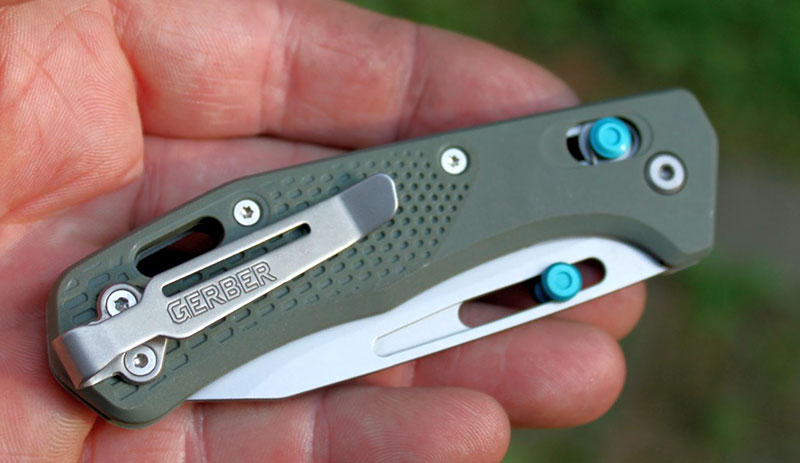
This minimalist construction in combination with slim dimensions (the handles are only 0.42” across, and the Assert measures just shy of 7” when open) helps to keep the weight down. There are still some details to delight the Instagram crowd, depending on which model you get. There’s a blackout version with black polymer handles, a black coated blade and black hardware, a grey handled version with a stonewashed blade and orange hardware, and my test version with a green handle and blue anodized hardware including the aforementioned thumb stud and standoffs. The polymer handles have a checkered texture that expands in width as it travels towards the rear of the handle, which wraps around the oval-shaped lanyard hole that’s situated between the two standoffs at the rear of the handle. Those steel liners peek out from the scales at the bottom of the handle as well as at the top, where you can gaze in and see the strange way that Gerber set up the washers on this model. They’re phosphor-bronze meaning they’re self-lubricating and break in gradually with use, but what’s especially strange is that they’re not a regular round shape, with a large surface area for better support of the pivot, and the washers are held in place by the stop pin and the pivot to prevent them from turning.
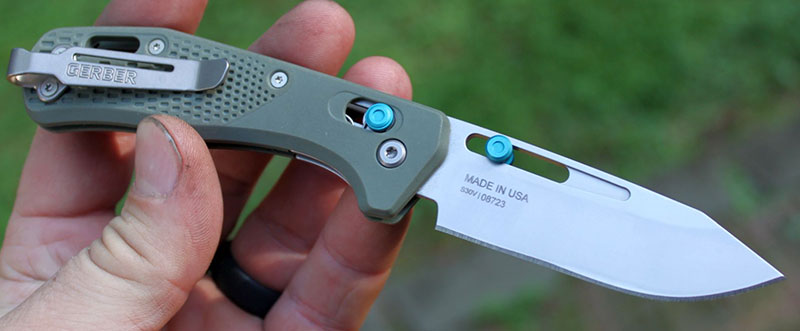
The Assert features a deep carry bent steel pocket clip that’s set up for ambidextrous tip-up carry, secured to the scales via two horizontal screws. Thanks to the switchable pocket clip, reversible thumb stud, and crossbar style lock, the Assert is fully ambidextrous, meaning there’s no disadvantage to a left-handed user. No complaints about fit and finish on this Gerber either – while molded polymer handles are never going to be as precise as machined G10 scales, the fit between the scales and the liners is good on the Assert, and the recessed countersunk body screws are a nice touch too. The blade came well-centered and it doesn’t wander when you adjust pivot tension – thanks to the oversized washers and the lack of lateral detent tension on the blade. My only fit and finish complaint was that the factory edge could have been sharper, an issue I’ve ran into with several Gerber products.
Field Test
After getting the pivot and thumb stud dialed in, the Assert quickly became one of my favorite knives to carry on a daily basis, up there with all-time greats like the Spyderco Para 3 Lightweight. Why? It carries so well. Weighing in at just 1.87 ounces, the Assert is light enough to forget it’s even there. While weight is important, it’s not everything: although this knife is 0.66oz heavier than the SOG Ultra XR folder, that knife ended up feeling more like a money clip with a knife added on than an actual pocket knife. It’s a balanced package: it’s exceptionally light but still extremely useful. The pocket clip is great, too: wide enough at the top to clear the hem of your jeans without a shove, a nice, angled tip for easy ingress and great tension so it doesn’t slide out of your pocket. There are no strange protrusions to catch on your hand in the pocket either, taking up minimal pocket real estate in addition to it’s light weight.

Ergonomics are a strong suit with the Assert, with the handle featuring a double-bump palm swell and a pronounced forward finger guard for a secure four-finger grip. It looks like the trend of extraneous jimping might be coming to an end, because there’s none to be found anywhere on this knife – not even on the spine in place of a thumb ramp, just smooth surfaces everywhere. Although the Assert’s quite thin, I prefer the ergonomics of it vs. the Bugout due to the taller profile of the handles giving you more volume to hold onto, although a thumb ramp or a forward choil would never go amiss.

I love the blade profile of the Assert, as high flat ground drop points cut from thin blade stock are generally very good at the type of day-to-day task cutting I do – cardboard, packaging, rubber hoses, zip ties, tape, clothing tags, that sort of thing. This isn’t the type of knife you’d want to pry or baton with, but for real “EDC” tasks it’s very good, and it’s a useful upgrade from the Savvy just in terms of grind and blade profile for slicing tasks. The only caveat here is the sharpening choil, which is very steep and tall, and tends to trap the material you’re cutting between it and the handle when you hold the blade at a certain angle, and issue that occurred frequently during my testing. Still, with a sharp tip, thin grind, and almost 3” of usable blade, there’s not much you can’t get done with the Assert.
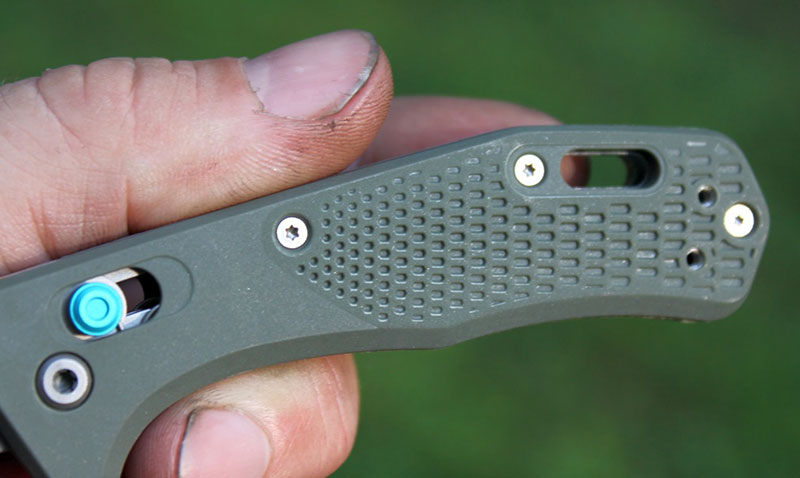
Maintenance and disassembly are complicated due to the funky washers and pivot lock setup, so a lot of care and dexterity are needed to take this knife apart and clean it, to avoid losing the springs which are under tension and just to get everything to line up. Thankfully, it has flow-through construction with the standoffs at the rear so you can just blow the knife out with compressed air and drop a little oil in the pivot periodically, as there’s no joy to be found disassembling bar lock knives. It does thankfully use standard Torx fittings for everything, so there’s no proprietary fasteners to deal with. S30V is never fun to sharpen – one of the reasons that S35VN exists, in fact – so I’d suggest using diamond abrasives to maintain the edge on this knife.
Alternatives
All these knives available at BladeHQ.
And here’s where we get to the problem with the Assert: the price and the competition. I try to do reviews price blind, with regards to features, fit and finish, and how they work in the real world, but you can’t ignore the price tag when it comes to the competition, and the Assert seems expensive for what it is. At $175 for the green or grey versions or $180 for the black-out variant, the Assert isn’t just aimed at the Bugout – it’s priced like the Bugout.Coming in at ~$150, the Mini Bugout – with its 2.875” blade, also cut from 0.09” thick CPM S30V blade stock, undercuts the Gerber by almost $25. Sure, the Gerber doesn’t have the flexi-flyer squishable handles that the Bugout does, which apparently doesn’t bother some people, but there’s the CF-Elite handled version of the Bugout for $162 with much stiffer scales. And while the Mini Bugout is about a half-inch shorter overall than the Assert, it’s also even lighter at only 1.5 ounces. The Assert’s weight and price are closer to the full-size Bugout CF Elite model, which rings in at $171 and 1.8 ounces with a slightly longer 3.24” blade. Being the company that invented the sliding bar lock, the action on the Bugout is better than the Assert as well. At basically the same price and specs as what is widely regarded as the favorite EDC knife of the entire community for years on end, I see an uphill battle for the Assert – which I think should have come in either cheaper or better equipped if it wanted to take on the crown, so to speak.

Then there’s the Hogue Deka, which is arguably an even better value for money than the Assert or the Bugout. At $135, the standard Deka offers a CPM Magnacut blade(!) measuring 3.25” from slightly thicker 0.11” blade stock in a long, thin clip point profile. With bright blue polymer handles and weighing in at a lightweight 2.1 ounces, the Deka offered more for less than the Bugout – better steel and more left in your wallet. You can also upgrade to a CPM-20CV version of the Deka for $166, which features nicer G10 handles and a slightly heavier 2.39oz weight, but it’s still under the retail price of the Assert – and 20CV is several steps above S30V in performance.

Finally, there’s the Kershaw Heist. It has some similarities to the others – slim handles, crossbar lock, deep carry pocket clip, a great EDC option. It’s 3.1” drop point blade is cut from slicey 0.09” blade stock just like the Assert. It’s a little heavier at 2.82 ounces, and it has D2 steel which is a step down from these other competitors. But it’s $55, so you can get three of them for the price of one Assert – one for you, one for your wife, and a backup for your glovebox maybe? And you’d have money left over for lunch. I’m still blown away by the value for money that the Heist offers.

Wrap-up
I really like the Assert, with just a few reservations. For one thing, it’s awesome to see Gerber actually putting out compelling knives that stand up on their own merits. First with the Fastball flipper, then the Sedulo and the Savvy, they’ve shown they’re serious about making good knives again, and I think the Assert is their best effort so far. I love its slim construction and light weight, useful blade shape, unique adjustable thumb stud, and great ergonomics. I just think it’s going in at too high of an MSRP to compete against established competitors in this market, and if they dropped the price 20 or 30 dollars it would probably be a killer deal. I still really like it and I’m finding it in my pocket with great regularity, so they’ve succeeded in that aspect. It makes me excited to see what else is coming down the line from America’s most well-known knife brand in the future.





